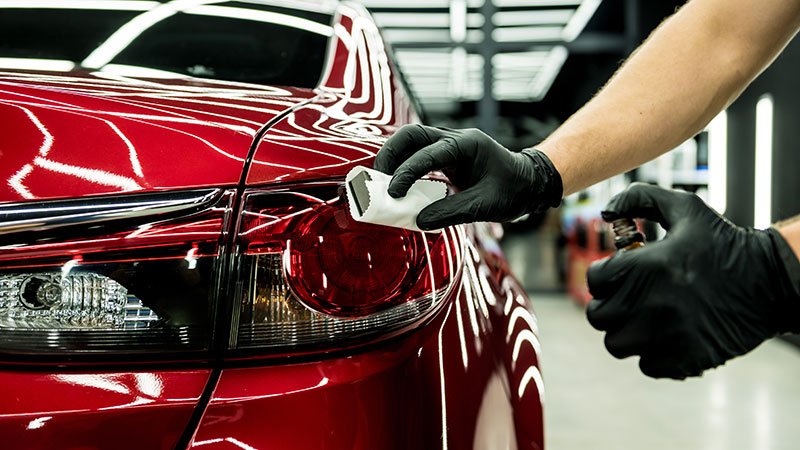How Outlining Ceramic Coating Boosts the Durability of Your Vehicle's Paint
Ceramic coating has actually emerged as a critical innovation in vehicle detailing, offering a durable service for preserving the stability of your vehicle's paint. Understanding the details of just how ceramic coating works and its advantages over standard wax can offer valuable insights for car owners.
What Is Ceramic Coating?
Recognizing the safety benefits of ceramic coating begins with recognizing its make-up and performance. Ceramic finishing is a fluid polymer used to the external surface areas of automobiles, mainly developed to boost and protect automotive paint. The vital part of this covering is silicon dioxide (SiO2), which is originated from all-natural materials like sand. This compound creates a solid chemical bond with the factory paint, creating a safety layer that is both long lasting and hydrophobic.
The covering's application includes thorough preparation of the car's surface area, which should be devoid of pollutants, scratches, and imperfections to make sure optimum adhesion. When used, the ceramic finish cures to create a stiff shield that can stand up to different environmental aspects, including UV rays, chemical spots, and oxidation.
In addition, ceramic coatings are not simply surface-level therapies; they permeate the paint to give a long lasting protection. This functionality prolongs the life-span of the vehicle's appearances while maintaining its value with time. Comprehending these basic facets of ceramic finishing is crucial for automobile proprietors looking for effective services for paint conservation and improvement.
Benefits of Ceramic Covering
The advantages of ceramic covering extend far beyond its basic safety attributes. Unlike typical wax or sealers, ceramic layers develop a solid bond with the cars and truck's paint, enabling it to stand up to environmental risks such as UV rays, acid rain, and roadway salt.
Additionally, ceramic coatings supply hydrophobic properties, suggesting they ward off water and contaminants. This particular not only makes the automobile simpler to tidy however additionally lessens the frequency of cleaning, conserving both time and effort for auto proprietors. The slick surface area created by the finish avoids dust and grime from sticking, enhancing the cars and truck's overall tidiness.
Moreover, ceramic finishes boost the depth and quality of the paint, giving automobiles a shiny finish that is aesthetically striking. This visual enhancement additionally adds to maintaining the cars and truck's resale value, as a well-kept outside is a significant selling point for possible buyers. Generally, the benefits of ceramic covering make it a rewarding investment for anybody aiming to protect and improve their lorry's paintwork.
How Ceramic Finish Works

The finish's hydrophobic homes ward off water and dust, protecting against the accumulation of gunk on the surface. This not only makes the auto less complicated to tidy but additionally lowers the probability of scratches and swirl marks triggered by typical cleaning methods. The ceramic layer acts as a guard against UV rays, which can cause fading and oxidation over time.
As soon as cured, the finishing exhibits impressive resistance to chemicals, including roadway salts, bird droppings, and tree sap, which can otherwise harm the paint. The durability of ceramic coverings can last for numerous years, depending upon factors such as upkeep and environmental conditions. On the whole, the chemical bonding process of ceramic layers offers a durable defense that preserves the integrity and look of a lorry's paintwork.
Comparing Ceramic Layer to Wax
Contrasting ceramic coating to typical wax reveals find this considerable distinctions in performance and durability. While both items aim to secure a car's paint, their structures and longevity set them apart. Wax, normally made from all-natural carnauba or synthetic products, provides a momentary guard that generally lasts only a couple of weeks to a few months, depending upon ecological conditions and maintenance routines.
In comparison, ceramic layers are sophisticated options made up of inorganic materials that bond chemically with the vehicle's paint. This creates a durable, semi-permanent layer of protection that can endure for a number of years. Consequently, ceramic coatings provide remarkable resistance to UV rays, chemical discolorations, and physical abrasion, dramatically reducing the risk of oxidation and fading.
Furthermore, the hydrophobic properties of ceramic coverings guarantee that water beads up and rolls off the surface, making it much more challenging for you could try this out dust and gunk to adhere. This simplicity of cleaning is a noteworthy advantage over wax, which can attract dust and require constant reapplication. Eventually, for cars and truck proprietors looking for durable defense and improved aesthetic appeal, ceramic coatings present an extra reliable option to conventional wax products.
Upkeep Tips for Long Life
Correct upkeep is important for maximizing the durability of a ceramic covering. Use a pH-balanced auto shampoo to protect against breaking down the coating, and prevent automatic cars and truck cleans with extreme brushes that can create micro-scratches.
To preserve the hydrophobic properties of the ceramic finish, consider applying an upkeep spray or booster especially developed for ceramic layers every few months. This will certainly strengthen the safety layer and boost water beading.
Additionally, prevent exposing the covered surface area to severe ecological conditions whenever feasible. Parking in shaded locations or making use of a cars and truck cover can stop UV damages and contamination from bird droppings, tree sap, or commercial results.
Finally, evaluate the layer occasionally for indicators of wear or damages. If you notice a decline in hydrophobic habits, it may be time for a specialist reapplication. By adhering to these maintenance pointers, lorry proprietors can considerably extend the life and efficiency of their ceramic layer, ensuring that their automobile's paint stays secured and aesthetically appealing for several years to come.
Conclusion
